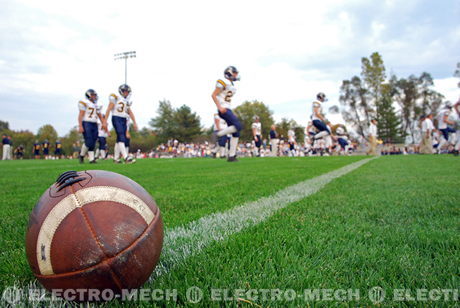
- Flag football fules are similar to tackle football rules, but there are some key differences.
- Among the areas in which flag football rules differ are stoppage of play, blocking, and fumbling.
- A common form of flag football has eight players on each side.
Number of Players
Flag football comes in many forms, and the number of players can range from four to nine. This article deals with how to play flag football with eight-person teams, as specified by the U.S. Flag Football Association. Four of the eight players must position themselves on the line of scrimmage. The players on the line are called linemen, and the others are called backfieldmen. Four officials are used in regulation games. This article focuses on how flag football differs from tackle football.
Equipment
The ball used in a flag football game should be made out of leather. Players should have jerseys with numbers on the front and the back. The numbers should be a color that contrasts with the surrounding color. No metal cleats or spikes are allowed on shoes. Each player must wear a belt with a flag attached to each of the two sides. The flags are 3 inches wide. The belts should be purchased from an approved manufacturer.
Stoppage of Play
The key difference between tackle football and flag football, of course, is that in flag football the ball carrier cannot be tackled. Tackling a ball carrier is cause for ejection from the game. The defender must remove a flag from the ball carrier’s belt, at which point an official whistles the play dead. The defender should hold the flag up above his head to help the official know that the play should be stopped.
In removing a flag, a defender should not use his head to make contact with the ball carrier or strike the ball carrier’s head. He also may not hold, push, or knock down the ball carrier. He may leave his feet to remove a flag. The ball carrier may not try to guard or protect a flag.
If a player inadvertently loses a flag, the play is dead and the ball is spotted where the flag hit the ground. If a receiver loses a flag and then catches a pass, the catch is allowed but the ball is dead at the spot of the catch. A ball carrier may not attempt to hurdle or knock down a defender.
A play is blown dead if any part of the ball carrier’s body except his hands or feet touches the ground. A play is also dead if a backwards pass or fumble touches the ground, or if the snap touches the ground after the ball’s initial movement off the ground.
Blocking
Blocking is allowed at the line of scrimmage but not downfield. A player may not leave his feet to block a defender. There is no blocking below the waist unless the blocker is pushed off balance by an opponent. A blocker must keep his elbows outside his shoulders.
Other Rules
All offensive players are eligible to catch a pass. There are four 15-minute quarters; if a game ends in a tie, each team has four plays to score from its opponent’s 20-yard line. Among the actions that result in penalties are intentionally removing a flag from a player who does not have the ball, and administering a stiff arm when carrying the ball.
As an electronic scoreboards continue to light up.

That is awesome that there is actually a US Flag Football Association. I didn’t even know there were actual rules. We always made up our own and then played and broke every rule we made. That’s what made it fun. Interesting to see how it is actually suppose to be played though.
I’m not so sure that I like the rule about “If a receiver loses a flag and then catches a pass, the catch is allowed but the ball is dead at the spot of the catch.” That seems like you could just run around and pull everyone’s flag right off the line and then they couldn’t run after they catch the ball. That’s stupid.
This seems like a very wussy way to play flag football. I understand that it is suppose to be more tame, but honestly, no blocking down field and no actual fumbles. It seems like there is very little that the defence can actually do to prevent any passes.
can a player leave his feet to avoid flag pull